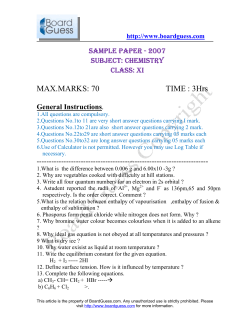
Tutorial #3 (Thermal Physics- Part II) (*Note: Definitions of all the
Tutorial #3 (Thermal Physics- Part II) (*Note: Definitions of all the symbols in the problems are given at the end of this tutorial) 1. Using the given thermodynamic data below for water (H2O), develop an equation for the saturation pressure (P) along the fusion line (it is a similar line to the saturation line/graph that we are familiar with, but is for solid to liquid phases, instead of liquid to vapor phases) as a function of temperature (i.e. develop an equation for P vs. T). Hint: use the Clapeyron equation for fusion. Next, using the equation you just developed find the saturation temperature of liquid water at a pressure of 30 MPa. Additional data given below: For saturated solid water (saturated ice) at 0.01°C: vi = 0.0010908 m3/kg hi = -333.4 kJ/kg (is negative) Pfus = 0.6113 kPa For saturated liquid water at 0.01°C: vf = 0.001 m3/kg hf = 0.01 kJ/kg Pfus = 0.6113 kPa 2. A container has a double wall where the wall cavity is filled with carbon dioxide (CO2) at room temperature and pressure. When the container is filled with a cryogenic liquid at 100 K the carbon dioxide will freeze so that the wall cavity has a mixture of solid and vapor carbon dioxide at the sublimation pressure. Assume that we do not have data for CO2 at 100 K, but it is known that at −90°C as: Psub = 38.1 kPa, hig = 574.5 kJ/kg. Estimate the pressure in the wall cavity at 100 K. Hint: use the Clapeyron equation for sublimation. (R for CO2 is 0.18892 kJ/kg K) 3. Develop expressions for changes in enthalpy (h) , internal energy (u) and entropy (s) for gas obeying each of the following equation of state and also that goes through an isothermal process, a) P (v − b) = RT. b) P = RT/(v – b) – a/v2 (Note: this is called the van der Waals equation of state. Also see the end of tutorial for the same equation) Where a and b are constants. Note 1: calculate the change of internal energies (u) using the change of enthalpies (h). (Note 2: If you get some free time, you may like to derive any equations that you use from basic principles, for your own benefit/practice) 4. Using the equation dh = Tds + vdP and one of Maxwell’s equations, a) find an expression for (∂h/∂v)T in terms of properties P, v and T. Then using this expression for an ideal gas what can you say about the shape of a constant T (i.e. isothermal) process curve in a h-v diagram b) find an expression for (∂h/∂T)v. Then using this expression for an ideal gas show that we get the result: Cp -Cv = R. Hint: Recall the definitions of Cp and Cv. 5. a) Use the equation dh = Tds + vdP and one of Maxwell’s equations to get an expression for the derivative (∂h/∂s)v for a constant volume process (i.e. isochoric process), that only includes the measurable properties P–v–T and the specific heat, Cv. Using this expression for an ideal gas what can you say about the shape of a constant v process curve in an h-s diagram? b) Use the equation Tds = du + Pdv and one of Maxwell’s equations to get an expression for the derivative (∂u/∂v)T for an isothermal (constant T) process, that only includes the measurable properties P–v–T. c) Use the equation du = (∂u/∂T)v dT + (∂u/∂v)T dv and the result you got in part b, to get an expression for the derivative (∂T/∂v)u for a constant internal energy (u = constant) process, that only includes the measurable properties P–v–T and the specific heat, Cv. (Hint: Recall the definition of Cv) For an ideal gas what can you say about the shape of a constant u process curve in a T-v diagram? Definitions of the symbols: v = Specific Volume h = Enthalpy u = Internal Energy s = Entropy 0 sT = Standard entropy hi = Enthalpy of saturated solid hf = Enthalpy of saturated liquid hg = Enthalpy of saturated vapor hfg = hg – hf hig = hg – hi sf = Entropy of saturated liquid sg = Entropy of saturated vapor sfg = sg – sf van der Waals equation of state: vi = Specific volume of saturated solid vf = Specific volume of saturated liquid vg = Specific volume of saturated vapor vfg = hg – hf vif = hf – hi ui = Internal energy of saturated solid uf = Internal energy of saturated liquid ug = Internal energy of saturated vapor ufg = ug – uf P = Pressure, T = Temperature Psat = Saturation Pressure Pfus =Saturation Pressure for fusion Psub= Saturation Pressure for sublimation Tsat = Saturation Temperature R = individual gas constant of the gas
© Copyright 2025









